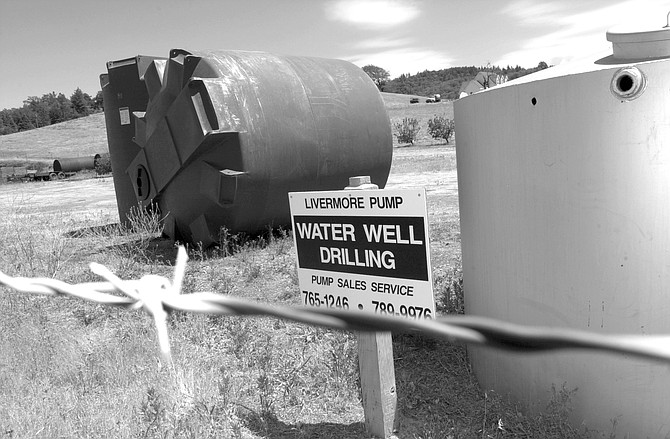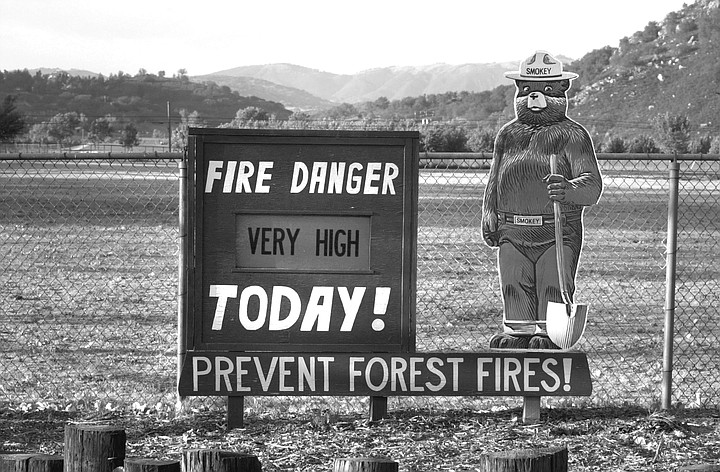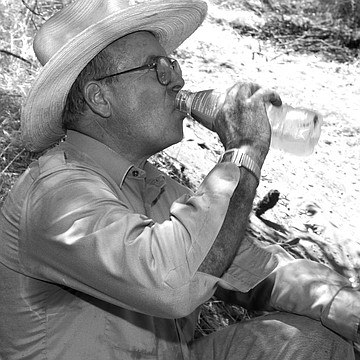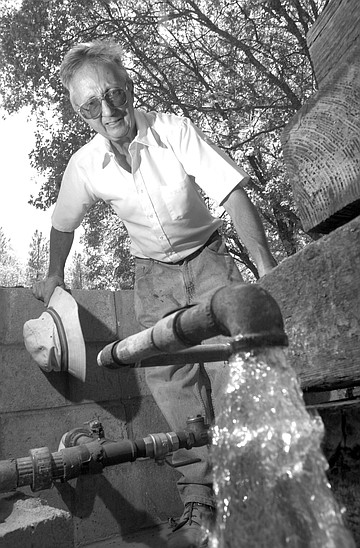 Facebook
Facebook
 X
X
 Instagram
Instagram
 TikTok
TikTok
 Youtube
Youtube

It's a muggy 93 degrees as I steer my car up the winding, climbing driveway of Buzz Machey's property in Julian. Near the top of the drive, I swing left to avoid a ten-wheel diesel truck with its front wheels six feet in the air. Two hydraulic lifts vertically position a 45-foot drill rig mounted to the bed of the truck. Two young men, their ears plugged against the deafening racket of the working drill, stand and wait for signs that the drill has hit water.

When I reach the modest green cabin house, Machey walks out to meet me. He's a stocky man around 60. Dressed in dusty blue jeans, a worn-out, red button-down shirt, and a grease-stained blue cap advertising Bombardier farm equipment, he's as rugged as the gnarled red-barked manzanitas that dot his land. "I've been here over 35 years," Machey says. "In all that time I've had a well 300 feet deep. Never had a problem."

But recently, Machey's well dried up — hence the drill rig growling down the hill in front of us. For a moment, he stares silently at the noisy drill, teeth clenched. "They just passed 560 feet," he finally says. "Still no water."

Stories like Machey's are not uncommon these days around Julian. The area is in the midst of a drought long-timers are calling the worst they've ever seen. (This week's 5000+ acre Julian fire was aided by the low-moisture content of the area's brush.) If you ask the locals what Julian's average rainfall is, they'll likely answer 30 to 32 inches. That may be wishful thinking. According to the California Department of Forestry records, 25.49 inches of rain is the annual average for Julian since July 1951. (Annual records are kept July of one year to June of the next.) The current 20-year average is 27.97 inches.
But the last time that much rain fell was the year of El Niño, July 1997 to June 1998, when 53.07 inches fell on the mountain town. The next three years were below average: 20.25 inches in 1998-1999, 19.51 in 1999-2000, 19.92 in 2000-2001. And the 12 months from July 2001 to June 2002 were the driest on record. Less than 10.5 inches fell on Julian in that span. Three years of below-average rain followed by one bone-dry year has resulted in well problems for the area.
"Recently, I've had about 14 wells that all of a sudden went marginal," says Craig Enloe, a 30-year Julian resident who owns a local water-systems business. Though he subcontracts the drilling to companies from "down the hill," he installs the pumping systems that connect wells to homes. "By marginal," he explains, "I mean they were keeping up with people's household activities, but just barely. I've had to have five or six other wells deepened because there was nothing there."
Enloe, a blue cap shading his bespectacled eyes, leans on the side of his pickup parked in an apple orchard in the Farmer's area north of Julian while his son, Marty, fits a valve to the head of a newly drilled well 50 feet away. "The average depth of a well up here," Enloe continues, "is about 300 feet. A few of them that were drilled during El Niño years are even shallower, maybe 120 feet deep. They thought, 'Hey, we have got plenty of water, so let's quit.' Well, you at least have to go to 300 up here, because that gives you storage capacity, and it kind of puts you down at the bottom of the tank, so to speak."
But Enloe says that the old 300-foot paradigm is no longer valid. "We've had three years of drought," he says, "and now we're having to go 400, 500, 600 feet. Some are even 700 and 800 feet."
Drought is only part of the dry-well equation, Enloe is quick to point out. Demand is the other factor. More wells have been dug and more water pulled out of the ground as more people have moved to the mountains. And Enloe says they have brought a city water-use mentality with them. "In the last five or six years, we have had a lot of new people move up here and build weekend houses. And because they have a well, they think they have unlimited water. And they want extensive landscaping, they want ponds, and they start watering a lot of grass. But this country is basically a desert. You go east, and in about four miles from here you're in the desert. But they think that because they have a well, that they have unlimited water, and they don't consider what the impact might be for their neighbors. It is nice to have landscaping, but people also like to take a shower and brush their teeth. So people need to be aware that it is not an unlimited amount, and when we run out up here, you can't call San Diego Water Department and say, 'Hey, we are out of water.' If you own a piece of property, you need to be a steward of the property. You can't bring a city mentality up here -- that the water will always be there when you turn on the tap."
Enloe chuckles and shakes his head as an anecdote comes to mind. "Just over the hill over here, there is a guy from Rancho Santa Fe who is trying to water all of his pine trees that are distressed, and he pumped his well dry. And I told him when he first moved up there that he'd run the well dry if he tried to water the landscape. And he called me because he was panicked; his tank was empty and he says, 'Let me tell you what I was doing.' And I said, 'Mike, you can't do that, I told you that. The wells up here should be for your household, so you can shower and flush the toilet. If you've got any extra, then that is good, but you can't go hog wild with it.'"
In Buzz Machey's mind, increased population is most of the problem. He scoffs at the suggestion that extended drought caused his well to run dry. "We've had dry years before and never had a problem with our well. It's the people. They've built more houses up here than the water supply can handle. And they're still giving out permits. If these people are going to be living out here, they've got to learn to manage water. Don't come up here and plant a big lawn that needs watering every day."
Speaking of lawns, while Machey is drilling a new well, just down the hill from his house, the Julian High School football field grows plush and green. "Just before noon," Machey's chin quivers with anger, "I drove into town, and they were watering that whole field in the midday heat. They're dumping so much water on that field that it's draining out of some big drainpipes they installed under it, and it's forming a creek" -- he pronounces it crick -- "which runs downhill into a pond, which is full to the top. There are dried-up ponds all over Julian, which in 35 years I've never seen dry. But that pond is full. I've spoken to the school superintendent and asked if they could back off the watering to the point where it wasn't running off, but it's still happening."
Humans aren't the only creatures suffering due to drought in the backcountry. Trees are dying off at an alarming rate. Around Santa Ysabel and Mesa Grande, northwest of Julian, it's the Engelmann oaks that are dying. More than half are in a stressed state in which they drop their leaves and enter a drought-induced dormancy. Around Julian it's the Coulter pine that is suffering due to drought, though indirectly so. Barbara Mansky, who lives with her husband Walter in a mountain lodge-style house near Machey's, looks out her kitchen window at a stand of Coulter pines on her property. Half of their needles are golden brown, an indication that the trees are dying. "It's the beetles that kill them," she explains. "When there's enough rain and the water is up, the tree produces a lot of sap and encases the beetle larva. What's happened now is the water table has dropped below the root zone, so the pines don't get any water, and then they can't defend themselves against the beetles. Once they go, it's amazing. They change from green to brown in about a week."
Though the well they've had for 25 years isn't dry, it's close. So they recently drilled a new one 750 feet deep. "It costs $12 per foot," says Walter, a slender, kind-faced man in his 60s. Leaning against the high kitchen counter in his split-level house, he adds, "But that's just the drilling."
Barbara, sitting at the kitchen table with a glass of ice water, says with a German accent, "The pump is about $1000, and there's the pipe that goes down the well. So by the time it's all said and done, it's $20,000..."
"No, no, no," Walter gently interrupts his wife. "It's $14,000 to $15,000."
One thing they agree on is what will happen to Julian if the area receives another year of minimal rainfall. Walter shakes his head and lets out a long, low whistle. Barbara gives words to the sentiment: "It will be a disaster."
Enloe agrees. "Property values would plummet, people would have to haul in water to sustain themselves. People are already hauling water. And then the question is, where do you get the water from? You are not going to get it from up here, so you are going to have to truck it in from down below. That's very expensive, so it will be one of those deals of the haves and have-nots. If we don't have something good happen next winter, then it is going to be a disaster up here."


It's a muggy 93 degrees as I steer my car up the winding, climbing driveway of Buzz Machey's property in Julian. Near the top of the drive, I swing left to avoid a ten-wheel diesel truck with its front wheels six feet in the air. Two hydraulic lifts vertically position a 45-foot drill rig mounted to the bed of the truck. Two young men, their ears plugged against the deafening racket of the working drill, stand and wait for signs that the drill has hit water.

When I reach the modest green cabin house, Machey walks out to meet me. He's a stocky man around 60. Dressed in dusty blue jeans, a worn-out, red button-down shirt, and a grease-stained blue cap advertising Bombardier farm equipment, he's as rugged as the gnarled red-barked manzanitas that dot his land. "I've been here over 35 years," Machey says. "In all that time I've had a well 300 feet deep. Never had a problem."

But recently, Machey's well dried up — hence the drill rig growling down the hill in front of us. For a moment, he stares silently at the noisy drill, teeth clenched. "They just passed 560 feet," he finally says. "Still no water."

Stories like Machey's are not uncommon these days around Julian. The area is in the midst of a drought long-timers are calling the worst they've ever seen. (This week's 5000+ acre Julian fire was aided by the low-moisture content of the area's brush.) If you ask the locals what Julian's average rainfall is, they'll likely answer 30 to 32 inches. That may be wishful thinking. According to the California Department of Forestry records, 25.49 inches of rain is the annual average for Julian since July 1951. (Annual records are kept July of one year to June of the next.) The current 20-year average is 27.97 inches.
But the last time that much rain fell was the year of El Niño, July 1997 to June 1998, when 53.07 inches fell on the mountain town. The next three years were below average: 20.25 inches in 1998-1999, 19.51 in 1999-2000, 19.92 in 2000-2001. And the 12 months from July 2001 to June 2002 were the driest on record. Less than 10.5 inches fell on Julian in that span. Three years of below-average rain followed by one bone-dry year has resulted in well problems for the area.
"Recently, I've had about 14 wells that all of a sudden went marginal," says Craig Enloe, a 30-year Julian resident who owns a local water-systems business. Though he subcontracts the drilling to companies from "down the hill," he installs the pumping systems that connect wells to homes. "By marginal," he explains, "I mean they were keeping up with people's household activities, but just barely. I've had to have five or six other wells deepened because there was nothing there."
Enloe, a blue cap shading his bespectacled eyes, leans on the side of his pickup parked in an apple orchard in the Farmer's area north of Julian while his son, Marty, fits a valve to the head of a newly drilled well 50 feet away. "The average depth of a well up here," Enloe continues, "is about 300 feet. A few of them that were drilled during El Niño years are even shallower, maybe 120 feet deep. They thought, 'Hey, we have got plenty of water, so let's quit.' Well, you at least have to go to 300 up here, because that gives you storage capacity, and it kind of puts you down at the bottom of the tank, so to speak."
But Enloe says that the old 300-foot paradigm is no longer valid. "We've had three years of drought," he says, "and now we're having to go 400, 500, 600 feet. Some are even 700 and 800 feet."
Drought is only part of the dry-well equation, Enloe is quick to point out. Demand is the other factor. More wells have been dug and more water pulled out of the ground as more people have moved to the mountains. And Enloe says they have brought a city water-use mentality with them. "In the last five or six years, we have had a lot of new people move up here and build weekend houses. And because they have a well, they think they have unlimited water. And they want extensive landscaping, they want ponds, and they start watering a lot of grass. But this country is basically a desert. You go east, and in about four miles from here you're in the desert. But they think that because they have a well, that they have unlimited water, and they don't consider what the impact might be for their neighbors. It is nice to have landscaping, but people also like to take a shower and brush their teeth. So people need to be aware that it is not an unlimited amount, and when we run out up here, you can't call San Diego Water Department and say, 'Hey, we are out of water.' If you own a piece of property, you need to be a steward of the property. You can't bring a city mentality up here -- that the water will always be there when you turn on the tap."
Enloe chuckles and shakes his head as an anecdote comes to mind. "Just over the hill over here, there is a guy from Rancho Santa Fe who is trying to water all of his pine trees that are distressed, and he pumped his well dry. And I told him when he first moved up there that he'd run the well dry if he tried to water the landscape. And he called me because he was panicked; his tank was empty and he says, 'Let me tell you what I was doing.' And I said, 'Mike, you can't do that, I told you that. The wells up here should be for your household, so you can shower and flush the toilet. If you've got any extra, then that is good, but you can't go hog wild with it.'"
In Buzz Machey's mind, increased population is most of the problem. He scoffs at the suggestion that extended drought caused his well to run dry. "We've had dry years before and never had a problem with our well. It's the people. They've built more houses up here than the water supply can handle. And they're still giving out permits. If these people are going to be living out here, they've got to learn to manage water. Don't come up here and plant a big lawn that needs watering every day."
Speaking of lawns, while Machey is drilling a new well, just down the hill from his house, the Julian High School football field grows plush and green. "Just before noon," Machey's chin quivers with anger, "I drove into town, and they were watering that whole field in the midday heat. They're dumping so much water on that field that it's draining out of some big drainpipes they installed under it, and it's forming a creek" -- he pronounces it crick -- "which runs downhill into a pond, which is full to the top. There are dried-up ponds all over Julian, which in 35 years I've never seen dry. But that pond is full. I've spoken to the school superintendent and asked if they could back off the watering to the point where it wasn't running off, but it's still happening."
Humans aren't the only creatures suffering due to drought in the backcountry. Trees are dying off at an alarming rate. Around Santa Ysabel and Mesa Grande, northwest of Julian, it's the Engelmann oaks that are dying. More than half are in a stressed state in which they drop their leaves and enter a drought-induced dormancy. Around Julian it's the Coulter pine that is suffering due to drought, though indirectly so. Barbara Mansky, who lives with her husband Walter in a mountain lodge-style house near Machey's, looks out her kitchen window at a stand of Coulter pines on her property. Half of their needles are golden brown, an indication that the trees are dying. "It's the beetles that kill them," she explains. "When there's enough rain and the water is up, the tree produces a lot of sap and encases the beetle larva. What's happened now is the water table has dropped below the root zone, so the pines don't get any water, and then they can't defend themselves against the beetles. Once they go, it's amazing. They change from green to brown in about a week."
Though the well they've had for 25 years isn't dry, it's close. So they recently drilled a new one 750 feet deep. "It costs $12 per foot," says Walter, a slender, kind-faced man in his 60s. Leaning against the high kitchen counter in his split-level house, he adds, "But that's just the drilling."
Barbara, sitting at the kitchen table with a glass of ice water, says with a German accent, "The pump is about $1000, and there's the pipe that goes down the well. So by the time it's all said and done, it's $20,000..."
"No, no, no," Walter gently interrupts his wife. "It's $14,000 to $15,000."
One thing they agree on is what will happen to Julian if the area receives another year of minimal rainfall. Walter shakes his head and lets out a long, low whistle. Barbara gives words to the sentiment: "It will be a disaster."
Enloe agrees. "Property values would plummet, people would have to haul in water to sustain themselves. People are already hauling water. And then the question is, where do you get the water from? You are not going to get it from up here, so you are going to have to truck it in from down below. That's very expensive, so it will be one of those deals of the haves and have-nots. If we don't have something good happen next winter, then it is going to be a disaster up here."
Comments